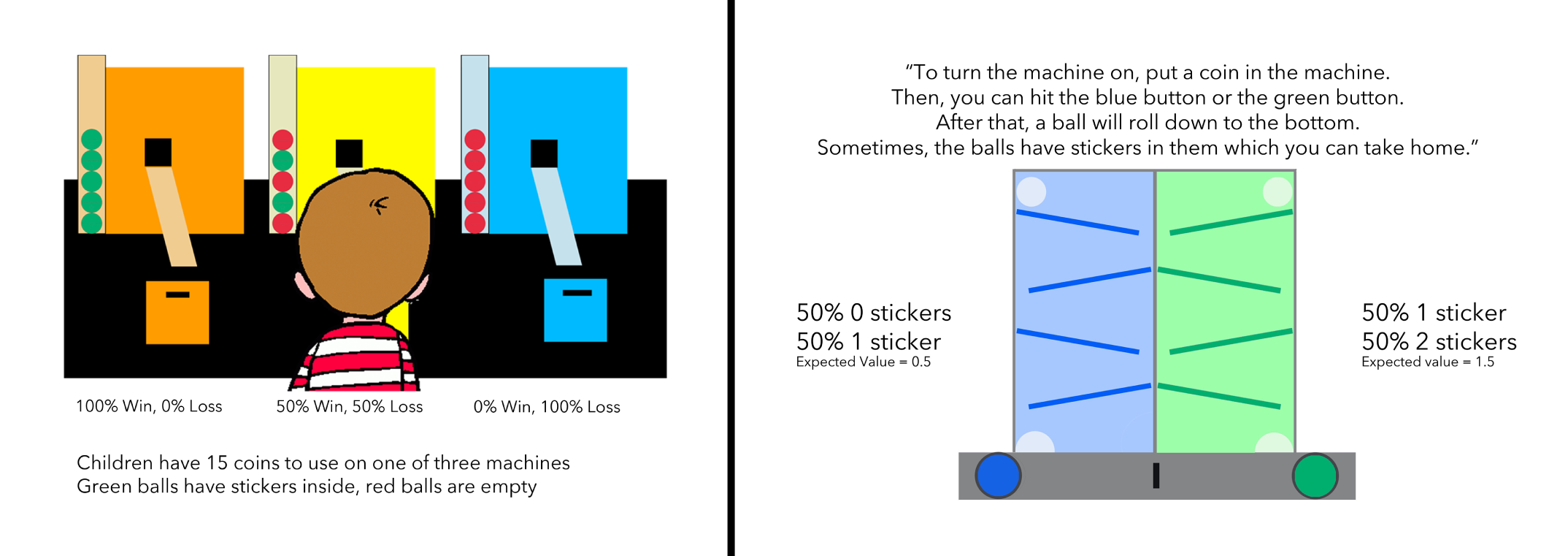Emily Sumner
My new website can be found here.

My new website can be found here.

I am interested in how children explore the world and make decisions.
Collaborators: Barbara Sarnecka, Mark Steyvers, & Celeste Kidd

Projects on Decision Making
Collaborators: Susanne Jaeggi, Barbara Sarnecka, Ryan Stokes, & Percy Mistry
Developed with: Grace Lin, Roldan Melcon, Matt Cooper, Grace Lin, Helena Kent, Angel Lopez, Armando Somoza, Russell Cohen Hoffing, Aaron Seitz, and Susanne Jaeggi.
Collaborators: Celeste Kidd, Noah Goodman, Erika DeAngelis, & Mara Hyatt
Sumner, E., DeAngelis, E., Hyatt, M., Goodman, N., & Kidd, C. (2015) Toddlers Always Get the Last Word: Recency biases in early verbal behavior. Proceedings of the 37th Annual Meeting of the Cognitive Science Society.
[PDF]
Sumner, E., Stokes, R., Mistry, PK., Jaeggi, S., & Sarnecka, BW. A freshly baked perspective on how we measure risk propensity. [In Prep, email for preprint]
Sumner, E., DeAngelis, E., Hyatt, M., Goodman, N., & Kidd, C. Toddlers Always Get the Last Word: Recency drives children's question answering. [Under review, email for preprint]
Sumner, E., Lomeli, A., Lee, M., & Sarnecka, BW. Too risky for you, but not for me: individual differences in preschooler's decision-making strategies [in prep]
Sumner, E., Harder, E., & Jaeggi, S. Delay Discounting: A measure of risk propensity or working memory? [in prep]
Sumner, E., Lee, M., & Sarnecka, BW (2017) Spin at your own risk: individual differences in preschooler’s decision-making strategies. Annual Meeting of the Society of Judgement and Decision Making. Vancouver, Canada. Poster.
Sumner, E., Stokes, R., Mistry, PK., Jaeggi, S., & Sarnecka, BW (2017) Measuring Risk Propensity in Young Children. 58th Annual Meeting of the Psychonomics Society. Vancouver, Canada. Poster.
Sumner, E., Lee, M., & Sarnecka, BW (2017) Spin at your own risk: individual differences in preschooler's decision-making strategies. Biannual Meeting of the Cognitive Development Society. Portland, OR. Poster.
Sumner, E., Melcon, R., Lin, G., Cooper., M., & Kent., H. (2017) Shima: A Virtual Reality Measure of Risk Propensity. Games for Change Festival, New York, NY. Talk.
Sumner, E., Stokes, R., Mistry, PK., Jaeggi, S., & Sarnecka, BW (2017) Developing Touchscreen Games to Measure Risk Propensity in Younger Children. Annual Meeting of the Engaged Learning Network at the Games for Change Festival, New York, NY. Poster
Sumner, E. (2017) Investigating individual differences in preschooler's decision-making strategies. SoCal Conference on Cognitive and Language Development. San Diego, CA. Talk.
Sumner, E., Lee, M., Sarnecka, BW. (2016) Investigating Individual Differences in Risk-Taking Preferences Among Preschoolers. 57th Annual Meeting of the Psychonomics Society, Boston, MA. Poster. [Technical Supplement].
Sumner, E., DeAngelis, E., Hyatt, M., Goodman, N., & Kidd, C. (2015) Toddlers Always Get the Last Word: Recency biases in early verbal behavior. 37th Annual Meeting of the Cognitive Science Society, Pasadena, CA. Talk.
Sumner, E., DeAngelis, E., Hyatt, M., Goodman, N., & Kidd, C. (2015) Toddlers Always Get the Last Word: Recency biases in early verbal behavior. University of Rochester Undergraduate Research Symposium, Rochester, NY. Talk.
Sumner, E. (1999) My MRI. Published by Mass General Hospital for Children, over 10,000 copies distributed.
Peer-Reviewed Conference Proceedings
Under Review/ In Prep Manuscripts
Conference Presentations
Books
I grew up outside of Boston, MA. I completed my undergraduate education in Brain and Cognitive Sciences at the University of Rochester. I am a strong supporter of open science. Other than science, I enjoy running, hiking, baking, and folk music.



